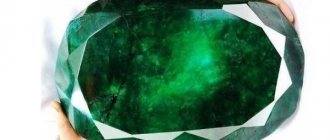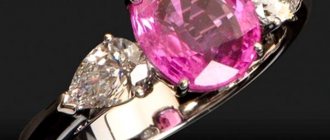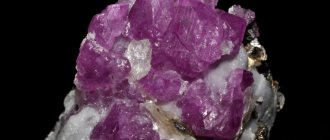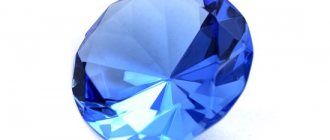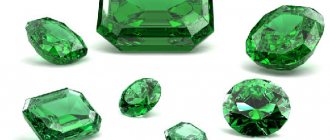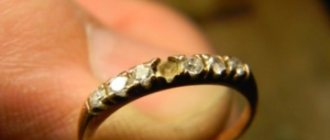A real ruby is a source of magical and healing properties that have a complex effect on the condition of the wearer. It is possible to obtain a set of useful qualities of a mineral only if you wear a stone mined from natural sources, because the earth gives the bright pebble amazing properties. Unscrupulous sellers have long learned to pass off glass as a precious stone, and modern technologies have made it possible to synthesize artificial rubies that are perfect in appearance and physical properties. But neither one nor the other is capable of providing a healing and magical effect, so it is important to know how to determine the authenticity of a ruby. How to distinguish a ruby from a fake at home and how jewelry experts do it - you will learn in the article presented to your attention.
Specifics and types of ruby
Ruby is a red variety of corundum. Myanmar (formerly Burma) is considered the main place for mining the precious stone. Burmese species are characterized by a rich and bright bloody scarlet color. This unusual shade is often called “dove’s blood.” The color here is distributed in streams and waves. And Burmese stones are quite expensive.
Some types of stones have a fluorescent effect due to the content of small amounts of chromium or iron. In the dark, such a ruby begins to glow, and under artificial lighting it acquires a bright blue color. Under red light, the color waves become stronger.
Other types are characterized by a faint flicker that comes from the inside from the center. As a result, the stone resembles a star. Rubies often change color depending on the type and degree of lighting. For example, breeds from Sri Lanka are pale pink in daylight, but turn blood red in the evening or under artificial light.
Light to the rescue
In the event that you don’t have a magnifying glass at hand, and the store salesperson refuses to provide it, casting doubts about the authenticity of the product, you can try playing with light.
Natural stone, exposed to the rays of sunlight, will reveal all its incredible beauty. The side that is illuminated by the sun will exude an amazing burgundy shine. On the reverse side, the surface will remain matte with a pale glow.
If you have an ultraviolet flashlight with a wavelength of 280 nm at your disposal, then you can dedicate it to the ruby. The original stone will not change the color of the glow, it will remain red. The imitation will sparkle with orange tones when exposed to ultraviolet light.
The “pigeon’s blood” effect, characteristic of real rubies, is clearly visible when the product is turned in different directions in daylight. The gem shimmers with purple hues. Imitation material does not have this effect.
For reliable results, you can use two testing methods simultaneously - viewing the sample through a magnifying glass and in sunlight.
Characteristics and properties of stone
- Increased hardness and heavy weight. Ruby belongs to the first class of hardness and is one of the strongest minerals. Even if you drop a stone on a glass or metal surface, there will be no scratches, chips or other damage on the product;
- Clear cut. Dense and careful processing allows you to obtain products with smooth and regular cuts without irregularities, deformations and bends;
- Color variety. As we have already found out, real stone changes color and shades depending on the lighting. The main color is red. However, when exposed to daylight, nightlight or artificial light, it can turn pink, dark, burgundy and so on. Sometimes rocks combine several shades at once, resulting in exquisite play, transitions and fusions;
- Shine. A strong shine with a glossy effect will help identify a real ruby. Such stones glare and shine through;
- Glow or fluorescent effect. Real rocks contain about 2% chromium, which creates a shimmering and purple glow effect. This effect can be noticed if you rotate the crystals. Artificial stone cannot boast of such a glow.
Modern methods of growing rubies
Now you can make rubies even at home, some people make a business out of it.
View this post on Instagram
Posted by Moissanita Jewelry Delivery (@moscowshine) Jul 2, 2020 at 4:11 PDT
Methods for synthesizing artificial crystals
Verneuil's method was the first in the history of synthesizing rubies. This method uses a Verneuil furnace, in which metal oxides are melted in a fire (the color changes depending on the choice of oxide). The resulting liquid then cools and forms crystals. This method has been used since 1903. Its advantages are that it is not necessary to monitor the melting temperature and the growth of the crystal can be observed.
Czochralski method. It began to be used in 1950. The crystal is formed by drawing from a large alloy of metals that crystallize in the process and using a seed crystal.
Zone melting. Used since 1952. Based on the solubility properties of various impurities. Used to obtain pure crystals.
Methods for home conditions
Verneuil's method adapted for home use. To implement it, you will need electricity and a mixture of chromium and aluminum oxides. Schemes of a simplified Verneuil furnace can be found on the Internet. This method is considered inexpensive and uncomplicated; it can also be used to produce artificial sapphires or topazes.
Ready-made kits for growing rubies – what are they? They consist of a special powder, a seed crystal and a stone base. Can be purchased at a board game store.
There are other ways to make a gem at home. Containers for the experiment must be clean and not previously used. Materials can be toxic, hide them from children and store them in a cool place.
Attention! To work safely with crystals, use gloves, a mask and safety glasses.
Growing crystals from sugar
Sugar is not the best material, as it is easily deformed, but it will do for the first time. For the experiment you will need: three glasses of sugar, red food coloring and 200 ml of water.
Growing goes through several stages:
- Make syrup from granulated sugar and water.
- While it is still cooking, add the dye and stir until completely dissolved.
- Cool the resulting liquid.
- Glue a thread 6–7 centimeters long to a cardboard strip.
- Glue a sugar crystal to one end of the thread with rubber cement.
- Pour the syrup into a glass and place a cardboard strip on top of it, lowering the thread with the crystal to the middle of the container.
- Cover with paper and wait for crystallization.
Growing Red Blood Salt Stones
This salt produces the most intense colors. You can order the powder on the websites.
Stages of producing ruby from salt:
- Dissolve blood salt powder in water heated to 90...94 °C.
- Leave the resulting solution: it should cool and begin to evaporate.
- Cover with paper and wait for crystallization.
You can put a flat stone there before evaporation - then a brush of crystals will form on it.
Growing stones from table salt
For this method, you need to have a transparent container, table salt and distilled water.
Growing stages:
- Warm the water to 45...50 °C and pour into a container.
- Add salt and stir until dissolved. Repeat the procedure until the salt begins to settle to the bottom. This will make the solution strong enough. During procedures, it is important to maintain the same temperature.
- Pour the solution into another container, making sure there is no sediment.
- Attach a salt crystal to a string and place it in a container. Wait for the crystallization process.
To add color, add food coloring to the saline solution.
How to recognize a ruby
To distinguish a real ruby from an artificial one, pay attention to the color and shine of the product. True rocks sparkle with a deep and bright red color. Do not forget that in different lighting they shimmer, glow and can change shade. Counterfeits do not have these properties. They are faded, and even if they sparkle, it is dim.
Cleanliness will help you recognize the naturalness of a stone. True breeds do not contain defects. They are smooth and even with a clear, sharp and dense cut. You can often find white spots, small scratches and flaws on the surface of fakes.
Try scratching the surface of the product with your fingernail or coin. There will be no trace left on a solid ruby. Only a diamond can scratch a real stone. But artificially grown rubies are easily scratched. If you carefully scratch a hard and smooth ceramic, glass or metal surface with a genuine stone, scratches will appear on such a surface.
Red scratches indicate that the material is artificially tinted, and the product consists of a softer mineral than a true ruby. Hold the material in your hands. The natural one heats up slowly, while the artificial sample heats up in a short time. In addition, natural breeds are heavier.
To distinguish a real ruby from a synthetic one, look at the contents of the bubbles. For a fake, they are filled with air, while for a precious stone, they are filled with red gases.
Useful information about rubies
To avoid falling for the tricks of scammers who offer to buy natural rubies at an affordable price, remember the uniqueness of the gemstone. Before concluding a transaction, be guided by the following facts:
- The cost of a high-quality bright red ruby starts at $10,000 per 1 carat. Such minerals are mined in quarries in Burma and are not supplied to jewelry stores, but are sold exclusively at auctions.
- Souvenirs are not made from expensive crystals; the stones are used only in the production of jewelry.
- For 50 years now, there have been no jewelry made from natural rubies in jewelry stores on the international market. The amount of red minerals remaining in the world determines their uniqueness and determines the price of the crystals.
- Antique stones of a dark burgundy hue from the oxide class, made before the 19th century, are a priori genuine. Jewelry with rubies was intended only for high-ranking officials and royalty, so jewelers did not even think about counterfeiting crystals.
Faceted rubies are edged with precious metals or set into tiaras, crowns and wands. Rings, earrings, necklaces and amulets with compact-sized gemstones are offered at auctions.
Only a gemologist after an examination can distinguish a natural stone from a skillfully cut fake grown in specially created conditions - visually the crystals are identical
Knowing how to determine the authenticity of a ruby, you don’t have to worry about the natural origin of the product. The main thing is not to forget to use useful information before purchasing a gemstone.
Types of fakes
Most often, garnet becomes a substitute for ruby. It is a dull dark red silicate mineral. It is easy to distinguish a ruby from a garnet. Place the stone in sunlight or place it under a lamp.
The natural mineral sparkles, sparkles and shimmers. Garnet will give a matte glow. In addition, it is capable of magnetization. Place the product on the scale and apply a magnet. If the mass has increased, you have a pomegranate in front of you. The original will not change the original weight.
Composite ruby is a stone combined from ruby and glass. This is an affordable and common method of counterfeiting, which increases the size of the product to increase the cost. In production, leftover or used rocks and composite red glass are used to cover chips, crumbs and other defects.
In this case, a comparison with a shard of red glass will help verify the authenticity of the ruby. They must be different. If the stone looks identical, you are most likely holding standard red composite glass. By the way, transparent light glass is often passed off as crystal. How to distinguish between crystal and glass, see here.
Tourmaline, like garnet, is classified as silicate materials. The product is distinguished by its pink-red color. It is harder than garnet, but softer than ruby. Try shining the stone with ultraviolet light. A true ruby will lose tone and become close to orange in color. The fake will remain red. We offer several more methods that will help you recognize a real crystal.
Checking at home
How to check if your jewelry is counterfeit on your own?
There are a number of methods that are inferior to professional ones, but at least can give reason to suspect something is wrong.
Ways to differentiate:
- Hardness. The properties of the stone are such that red corundum easily scratches and cuts glass and metal, except armor steels. Please note that if you can see a red mark in the scratch, this means that you have colored colorless corundum, for example leucosapphire, or a colored synthetic crystal. A ruby itself can only be scratched with a diamond.
- View the stone against the light in natural light. The side facing the sun will play and shine with bright reflections, while the side facing away from the sun will remain matte.
- Gas bubbles and other defects. The imitation is always flawless and has no defects. A real ruby may have cracks, but they are always zigzag-shaped; straight ones are a reason for suspicion. Gas bubbles in red corundum are always filled with scarlet gas; if they are light, it is a colored stone of a different breed.
- For comparison, just take a piece of red glass in the appropriate sizes. Ruby will stand out especially well against its background.
- From the warmth of your hands, red corundum heats up slowly, so it seems cold for a long time. Glass offered in this quality will become warm quickly.
- For a better test, lower the crystal into a transparent vessel with spring water. The real stone will begin to emit a reddish glow.
- Faceted corundum crystals have clear, even, “chopped” edges. They are noticeable when viewed under a tenx magnifying glass. Garnet, tourmaline or glass are identified in this way, but it will not be possible to distinguish a synthetic crystal or noble spinel.
- Be suspicious of a crystal whose lower part is not visible under the jewelry frame. This is probably a fake; most likely, the ruby was replaced with tourmaline, which has polychroism - two colors. Part of the stone of the “wrong” color is hidden under the setting.
There is a belief that a ruby placed in a bowl of cow's milk turns it pink.
Other gemstones are not capable of this.
Star ruby ring
It is interesting that it is almost impossible to fake a “star-shaped” ruby, in the center of which there is a six-rayed star made of three “rays” - rutile fibers.
But such stones are sold only at auctions.
How to check the authenticity of a ruby
Place the precious crystal in a vase, glass, or other glass container. A real ruby will glow, emitting a red beam. And in natural light, the shades of the product will begin to differ. So, opposite the sun on the front side it will become burgundy, and on the back it will become matte and pale.
Milk will help you distinguish a natural ruby from an artificial one. Place the stone in a glass of drink and the drink will change color. Snow-white milk will turn pink. And when you remove the ruby, the liquid will never return to its original white color.
When checking, experts recommend using a 10x jewelry magnifying glass. Carefully examine each defect and pay special attention to microscopic and small imperfections that are not visible without a magnifying glass. The fake will remain flawless, but the presence of minor defects indicates the naturalness of the material.
If you notice bubbles upon inspection, it is a fake. In addition, with a true breed, under a magnifying glass, you will be able to see the precise, clean and polished cut. Today you can often find a fake. For example, faience and cheap ceramics are passed off as real porcelain. How to distinguish porcelain products from fakes, see the link https://vsepodomu.ru/kuhnya/kak-otlichit-farfor-ot-keramiki/.
How to distinguish artificial corundum from natural one
The difference between natural stones and synthetic ones is formed by the list:
- The cost of the crystal is that natural stones are expensive. But this method cannot be used as the main one, since scammers make products with artificial stones that cost natural gems. In order not to be deceived, it is recommended to purchase products only from trusted representatives.
- It is recommended to examine the stone under an ultraviolet lamp. Artificial specimens will lose their color under light.
- The stone can be dipped into milk - if it turns pink, it means you have a natural gem.
- Stones can be weighed using a special device, which is difficult in everyday life. But artificial crystals have less weight. It is better to contact a jeweler before purchasing, who will be able to accurately determine the authenticity of a real stone.
- In synthetic stones you can see bubbles with the naked eye. They are large and empty. At the same time, in natural specimens you can find bubbles, but they have a red filling.
- Natural stone can become dark on its edges under certain lighting conditions. Artificial remains bright in any light.
These simple methods will help solve the problem of purchasing natural rubies.
Description
Corundum is a crystalline aluminum oxide with an uneven surface. The mineral is dichroic, dense and so hard that only diamond is harder than it. In nature, there are both individual minerals in the form of crystals and fused into “barrels” or columns. The natural colors of corundum are red, black, yellow, pink, white and green. And this is the first difference between corundum and ruby, which comes only in red or red shades.
Varieties of corundum include sapphire (blue, green, violet), leucosapphire, ruby, padparadscha, and amethyst.
As for ruby , the more chromium it contains, the deeper its red color. If you shine ultraviolet light on the stone, it will turn orange. Rubies can be obtained artificially (the Frenchman Auguste Verneuil succeeded for the first time in 1904); such samples are sometimes called spinel.
There is a theory that rubies are unripe sapphires. After the collapse of Pangea (an ancient single continent), one large deposit was destroyed. Some of the rubies remained in the rocks of the earth, where the stones under pressure continued to become saturated with metal oxides and “turned red.” The other part set off on a journey through oceans and rivers, turning blue and yellow along the way.
Conclusion
From the descriptions above, you can understand how a precious ruby differs from corundum. That not every stone of this type found is of high value. With all its varied colors, corundum in jewelry is used only in red and blue colors. Gems of other colors are successfully used in industry, mechanical engineering and electronics, because the stone has high hardness. Synthetic corundum is grown artificially and its cost is tens to hundreds of times lower than that of genuine precious minerals.
And the most interesting thing is that a certain paradox emerges. It is now known that ruby is corundum, but ruby is precious and corundum is not. This is such a mystery of nature.
